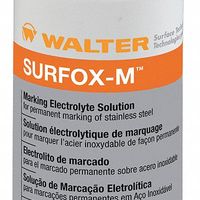Call +(254) 703 030 000 / 751 483 999 / 721 704 777
- Home
- Welding
- Weld Fixturing Marking Preparation
- Electrochemical Marking Etching Tools
.....Read More
Frequently Asked Questions
What is electrochemical marking and etching?
Electrochemical marking and etching is a process used to permanently mark or engrave metal surfaces with text, logos, or designs. This technique involves the use of an electrolyte solution, an electrical current, and a stencil to create the desired mark on the metal surface.
In electrochemical marking, a stencil with the desired design is placed on the metal surface. An electrolyte solution is applied to the stencil, and an electrode connected to a power source is used to pass an electrical current through the solution. The current causes a controlled chemical reaction that removes a thin layer of metal, creating a permanent mark. This process is often used for marking serial numbers, logos, or other identifying information on metal parts.
Electrochemical etching is similar but typically involves deeper penetration into the metal surface. It is used to create more pronounced engravings or patterns. The process can be adjusted by varying the current, time, and type of electrolyte to achieve different depths and finishes.
Both methods are favored for their precision, speed, and ability to produce high-quality, durable marks without damaging the integrity of the metal. They are commonly used in industries such as aerospace, automotive, medical devices, and manufacturing for part identification and traceability.
How does electrochemical marking work on metal surfaces?
Electrochemical marking, also known as electrolytic marking, is a process used to etch or engrave metal surfaces with permanent marks such as logos, serial numbers, or other identifiers. This method involves the use of an electrolyte solution, a stencil, and an electrical current to create the desired mark on the metal surface.
The process begins with the preparation of a stencil that contains the design or text to be marked. This stencil is typically made from a non-conductive material with cut-out areas that expose the metal surface where the mark is to be applied. The stencil is placed on the metal surface, ensuring proper alignment and contact.
An electrolyte solution, which is a conductive liquid, is then applied to the area of the metal surface exposed by the stencil. The choice of electrolyte depends on the type of metal being marked, as different metals require different solutions to achieve optimal results.
Once the stencil and electrolyte are in place, an electrical current is applied using a marking machine. This machine has two electrodes: one connected to the metal workpiece and the other to an applicator pad that is placed over the stencil. The electrical current flows through the electrolyte, causing a controlled electrochemical reaction at the exposed metal surface.
This reaction results in the removal of a thin layer of metal, creating a permanent mark. The depth and appearance of the mark can be controlled by adjusting the current, duration, and type of electrolyte used. The process is precise, allowing for high-quality, detailed markings without damaging the surrounding metal.
After marking, the metal surface is cleaned to remove any residual electrolyte and stencil material, leaving a clear, permanent mark that is resistant to wear and corrosion. Electrochemical marking is widely used in industries such as aerospace, automotive, and medical devices due to its efficiency and ability to produce durable, high-contrast marks.
What materials can be marked or etched using electrochemical tools?
Electrochemical marking or etching is a versatile process used to mark or etch a wide range of conductive materials. The primary materials that can be effectively marked or etched using electrochemical tools include:
1. **Metals**: Most metals and metal alloys are suitable for electrochemical marking. This includes:
- **Stainless Steel**: Commonly used in industrial and consumer products.
- **Aluminum**: Lightweight and used in aerospace and automotive industries.
- **Copper**: Used in electrical components and plumbing.
- **Brass**: Often used in decorative items and musical instruments.
- **Titanium**: Used in aerospace, medical devices, and high-performance applications.
- **Nickel and Nickel Alloys**: Used in various industrial applications.
- **Carbon Steel**: Widely used in construction and manufacturing.
- **Tool Steel**: Used for cutting and shaping tools.
2. **Precious Metals**: Electrochemical marking is also applicable to precious metals such as:
- **Gold**: Used in jewelry and electronics.
- **Silver**: Common in jewelry, tableware, and electronics.
- **Platinum**: Used in high-end jewelry and industrial applications.
3. **Other Conductive Materials**: Some non-metallic conductive materials can also be marked, such as:
- **Graphite**: Used in electrodes and certain industrial applications.
- **Conductive Polymers**: Used in specialized electronic applications.
The process involves using an electrolyte solution and an electric current to create a controlled oxidation or reduction reaction on the surface of the material, resulting in a permanent mark. The versatility of electrochemical marking makes it suitable for applications in industries such as aerospace, automotive, medical, electronics, and consumer goods, where durable and precise marking is essential.
What are the differences between marking and etching?
Marking and etching are both techniques used to create designs or information on surfaces, but they differ in their methods and applications.
Marking involves creating visible impressions on a surface without removing material. It can be done using various methods such as laser marking, inkjet printing, or dot peen marking. Laser marking uses a focused beam of light to alter the surface properties, creating high-contrast marks. Inkjet printing applies ink to the surface, while dot peen marking uses a mechanical stylus to indent the material. Marking is typically used for adding serial numbers, barcodes, logos, or other identifiers on products. It is fast, cost-effective, and suitable for a wide range of materials including metals, plastics, and ceramics.
Etching, on the other hand, involves removing material from the surface to create a design. This can be achieved through chemical, electrochemical, or laser etching. Chemical etching uses acids or other chemicals to dissolve material, while electrochemical etching uses an electrical current to remove metal ions. Laser etching employs a laser to vaporize material, creating a permanent mark. Etching is often used for intricate designs, circuit boards, or decorative purposes. It provides depth and texture to the surface, making it ideal for applications requiring durability and resistance to wear.
In summary, marking is a non-invasive process that alters the surface without material removal, suitable for identification and branding. Etching involves material removal, offering depth and durability, ideal for detailed designs and industrial applications.
What equipment is needed for electrochemical marking and etching?
Electrochemical marking and etching require specific equipment to ensure precision and effectiveness. The essential components include:
1. **Power Supply Unit**: A variable power supply is crucial to control the current and voltage applied during the process. It typically ranges from 5 to 30 volts, depending on the material and desired depth of the mark or etch.
2. **Electrolyte Solution**: This conductive liquid facilitates the electrochemical reaction. The type of electrolyte varies based on the material being marked or etched, such as stainless steel, aluminum, or titanium.
3. **Stencil**: A stencil is used to define the pattern or text to be marked. It can be made from materials like mylar or vinyl and is designed to resist the electrolyte while allowing the current to pass through the desired areas.
4. **Marking Head or Applicator**: This tool applies the electrolyte to the stencil-covered surface. It often consists of a handle with a pad or brush that absorbs the electrolyte and makes contact with the workpiece.
5. **Grounding Clamp**: A grounding clamp or electrode is necessary to complete the electrical circuit. It is attached to the workpiece to ensure the current flows through the desired path.
6. **Cleaning Supplies**: Post-marking cleaning is essential to remove any residual electrolyte and prevent corrosion. This typically involves water, neutralizing agents, and cleaning cloths.
7. **Safety Equipment**: Personal protective equipment (PPE) such as gloves, goggles, and aprons are important to protect against chemical exposure and electrical hazards.
These components work together to achieve precise and durable markings or etchings on metal surfaces, commonly used in industrial, manufacturing, and artistic applications.
How long do electrochemical marks last on metal surfaces?
The longevity of electrochemical marks on metal surfaces depends on several factors, including the type of metal, the environment in which the metal is placed, and the specific electrochemical marking process used. Generally, electrochemical marks can last from a few years to several decades.
1. **Type of Metal**: Different metals have varying levels of resistance to corrosion and wear. For instance, stainless steel, due to its chromium content, is more resistant to corrosion than carbon steel, which can affect the durability of the mark.
2. **Environmental Conditions**: Marks on metals exposed to harsh environments, such as high humidity, saltwater, or industrial pollutants, may degrade faster due to increased corrosion rates. Conversely, marks on metals kept in controlled, dry environments will last longer.
3. **Marking Process**: The depth and quality of the electrochemical mark also play a crucial role. Deeper marks are generally more durable as they are less susceptible to surface wear. The use of protective coatings or sealants can also enhance the longevity of the marks by providing an additional barrier against environmental factors.
4. **Maintenance**: Regular maintenance and cleaning of the metal surface can help preserve the marks. However, abrasive cleaning methods can wear down the marks over time.
In summary, while electrochemical marks can be quite durable, their longevity is not fixed and is influenced by the aforementioned factors. Proper selection of materials, environmental control, and maintenance can significantly extend the life of these marks.
Are there safety precautions to consider when using electrochemical marking kits?
Yes, there are several safety precautions to consider when using electrochemical marking kits:
1. **Personal Protective Equipment (PPE):** Always wear appropriate PPE, including gloves, safety goggles, and protective clothing, to prevent skin and eye contact with electrolytes and other chemicals.
2. **Ventilation:** Ensure adequate ventilation in the workspace to avoid inhaling fumes that may be released during the marking process.
3. **Chemical Handling:** Handle all chemicals, especially electrolytes, with care. Follow the manufacturer's instructions for safe use, storage, and disposal.
4. **Electrical Safety:** Be cautious of electrical hazards. Ensure that all equipment is properly grounded and inspect cables and connections for damage before use.
5. **Equipment Maintenance:** Regularly inspect and maintain the marking equipment to ensure it is in good working condition. Faulty equipment can pose safety risks.
6. **Training:** Ensure that all operators are adequately trained in the use of the electrochemical marking kit and are aware of the potential hazards.
7. **Emergency Procedures:** Be familiar with emergency procedures, including the location of eyewash stations and first aid kits, and know how to respond to spills or exposure incidents.
8. **Labeling and Signage:** Clearly label all chemicals and equipment, and use appropriate signage to warn of potential hazards in the area.
9. **Avoiding Contamination:** Prevent cross-contamination by using separate tools and containers for different chemicals and cleaning them thoroughly after use.
10. **Storage:** Store all chemicals and equipment according to the manufacturer's guidelines, away from incompatible substances and in a secure location.
By adhering to these safety precautions, you can minimize the risks associated with using electrochemical marking kits and ensure a safe working environment.


